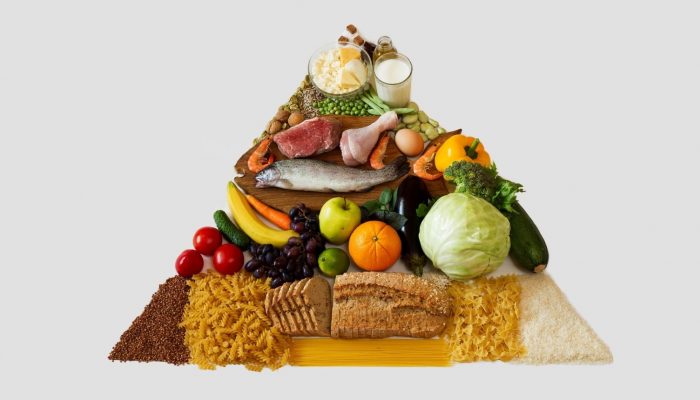
Dietary guidelines for millions of Americans were introduced by the USDA in 1992. The pyramid recommended 6–11 servings of grains per day. It started with fruits and vegetables, then protein and dairy, and finally fats, oils, and sweets, with the advice to “use sparingly.”
A vertical slice rather than stacked categories replaced the food pyramid in 2005. A new guideline, MyPlate, was introduced in 2011, replacing the old one. Fill your plate as the graphic suggests, and you’re on your way to a healthy meal.
Five experts discuss the Food Pyramid, MyPlate, and what we should eat today.
RIGHTS OF THE PYRAMID
The pyramid served a purpose even though it was no longer preferred. “The Food Guide Pyramid did educate people about the importance of whole grains, fruits, and vegetables,” says Amy Goodson, RD, MS. It taught us to eat a variety of foods.
“The Food Pyramid accurately depicts that all food fits into a healthy eating pattern,” says Liz Wyosnick, MS, RD, owner of Equilibriyum in Seattle. “It’s just a matter of eating the right foods.” For example, the sugar pyramid placed high-sugar foods at the very top, indicating that they should be consumed in moderation. The largest portions were fresh produce and whole grains, indicating their importance in your diet. “The food pyramid is a lovely metaphor. “Just as a pyramid’s strength and integrity come from a solid base, our health comes from a foundation of nutrition based on fresh, whole vegetables,” says Wyosnick. She notes that while the pyramid metaphor may have failed, it had good intentions.
FOOD PYRAMID FAILURE
The owner of Active Eating Advice, Leslie Bonci, RD, MPH, agrees. “The ideas were complex and hard to visualize, so some people read them top down.” She also says the pyramid’s recommendations were universal, when dietary needs vary. Aim for six to 11 grain servings per day, but not 11.
When the Food Guide Pyramid was first published in 1992, the country was on a no-fat/low-fat kick. ‘Sparingly’ using all fats was a major flaw in the pyramid, says Melissa Macher, RD, LD, owner of A Grateful Meal. No exceptions were made for nuts, avocados, or omega-3-rich fish. “There was also no clear distinction between complex and simple carbohydrates,” says Macher. The simplified pyramid muddled the public message and overall efficacy.
“The Food Pyramid’s low-fat, high-carbohydrate diet promotes unhealthy cholesterol and triglyceride levels,” says Samantha Cassetty, MS, RD, nutrition and wellness expert and co-author of Sugar Shock. This diet can increase your risk of heart disease and lower your good and bad cholesterol. “We now know a lot more about healthy foods and eating habits, and we’ve clarified much of the Food Pyramid’s advice.”
The Food Pyramid was also unclear. Cassetty notes that the protein targets were maximums, while the vegetable targets were minimums. Consumers were likely to miss the discrepancy unless they looked closely. While the guidelines were not necessarily harmful, Wyosnick claims they were confusing and difficult to use to accurately guide consumer food choices.
The pyramid did get people thinking about food, which is good. But the pyramid’s basic tenets pitted one category against another.
“In my opinion, the stacking of the food groups, particularly in the 1992 version, reinforced the binary of ‘good’ versus ‘bad’ food,” says Macher. Instead, it solidified moral attachments to food.
MYPLATE MOVE
It’s only natural that dietary advice, like medical advice, evolves. “MyPlate represents our current understanding of nutrition and health,” says Cassetty.
MyPlate addresses several Food Guide Pyramid issues. As an example, vegetables take precedence over grains, and fats aren’t relegated to the top of the plate — instead, dairy is served alongside the meal to complement it. A more consumer-friendly portrayal of education and implementation. The plate graphic is simple enough for everyone to understand.
“I like this representation because it is more relatable and easier to execute meal-by-meal,” says Wyosnick, who builds most of her meals around the balanced plate model: half produce, quarter complex carbs, and quarter protein. “I know it is macronutrient and micronutrient supportive.”
But it’s not perfect. For example, MyPlate’s recommendations still don’t fully address the nuances of dietary fat, according to Macher. She suggests Harvard’s Healthy Eating Plate, which provides more context than MyPlate and includes water consumption and physical activity.
“I like using a plate visual as a teaching tool, but I prefer giving much more personalized recommendations to my clients,” she says. “It is difficult to distill the nuance of food and nutrition from a scientific and cultural perspective. We can find more sustainable solutions by seeking the help of professionals who can assess not only your physical but also your mental and emotional health, preferences, and cultural practices.
VERDICT
The Food Guide The Pyramid was well-intended, but it isn’t today’s preferred diet. Whether you believe in plates, pyramids, or something else entirely, there are several agreed-upon practices for healthy eating. Generally, focus on fresh produce, lean proteins, whole grains, dairy, and healthy fats. Dietary advice includes all food groups.
Cassetty advises not to get discouraged if your eating habits aren’t up to par. “You can make small changes to your diet. For example, replace packaged snacks with fruit and nuts, and sugary drinks with water.”You don’t have to eat healthy all the time, and everyone deserves a treat now and then,” but even small steps toward healthier eating habits are positive steps. “

